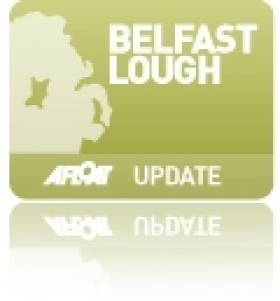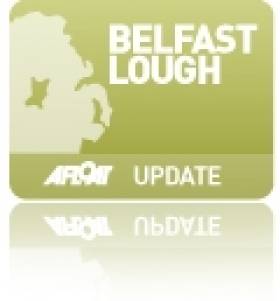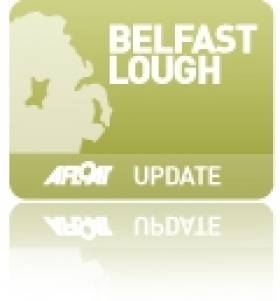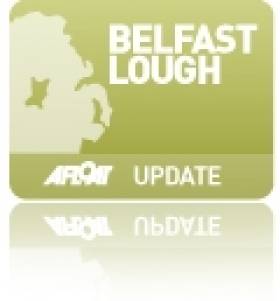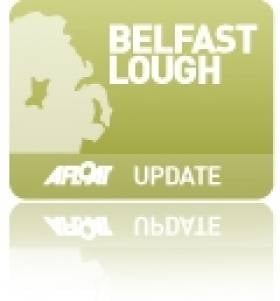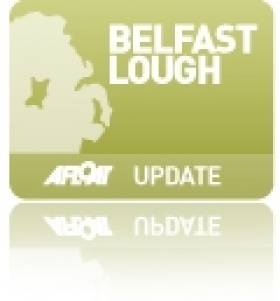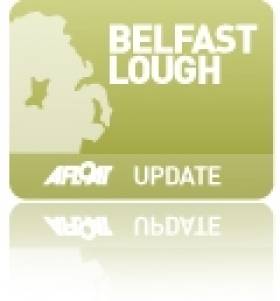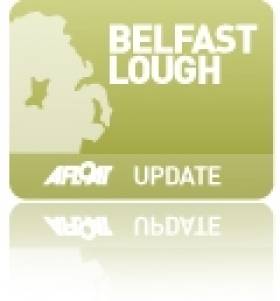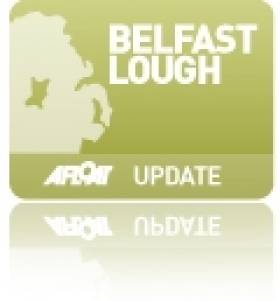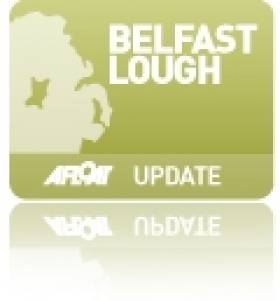Displaying items by tag: Belfast Lough News
Belfast Harbour's Public AGM
#BelfastPortAGM – Belfast Harbour's public AGM is to be held tomorrow (22 October) between 9.45am - 10.45am.
The venue is the Belfast Harbour Office on Corporation Square.
In order to anticipate demand, the organisers would appreciate if interested parties would notify in advance by e-mailing: or contacting Belfast Harbour office reception for details visit this link.
Belfast Harbour has in recent years invested £150m to develop port infrastructure. As previously reported on Afloat.ie, the port has embarked on a Masterplan for a period of over the next 20-30 years.
HMS Caroline Has Potential to be Key WWI Commemoration Project
HMScaroline – As previouslt reported, the Belfast-based former WWI warship HMS Caroline could create "one of the most significant World War One commemoration projects in the world".
The claim has been made by the grandson of the admiral who commanded the Royal Navy's Grand Fleet in 1916. HMS Caroline has been docked at Alexandra Dock in Belfast since 1923.
Plans to transform it into a floating museum are progressing. The fast light cruiser played a lead role in the 1916 Battle of Jutland in which the Royal Navy forced the German Imperial Navy to retreat to port.
For much more on this development, BCC News Northern Ireland has a report.
Harland & Wolff to Refit Huge Oil Rig is a Christmas Bonus
#Harland&Wolff – Harland & Wolff's landmark iconic cranes are to be relocated due to the refit of a massive oil rig which will act as the city's unofficial Christmas tree, bedecked with lights, as it towers over the harbour estate in a repair deal worth tens of millions of pounds.
The mammoth Blackford Dolphin oil drilling rig, originally built in 1974 in Norway, will be upgraded and repaired in the firm's 556m x 93m main building dock, starting in November for approximately 50 days.
The Aker H-3 rig underwent a major upgrade from 2006 to 2008, when Harland & Wolff designed and built accommodation blocks, power generation module, mud room and additional buoyancy.
For more on this story The Belfast Telegraph reports.
Belfast Harbour Port Masterplan: 20-30 Year Period
#BelfastPort – In this 400th anniversary year of Belfast Harbour which was established by a Royal Charter, the port in 2013 has embarked on a Port Master Plan for a period over the next 20-30 Years.
The Masterplan sets out Belfast Harbour Company's (BHC) medium to long term development plans for consultation in order to inform stakeholders and assist local and regional planning authorities to prepare and revise their own plans.
BHC plays an essential role in the local economy of Belfast and regional economy of Northern Ireland. The Northern Ireland economy is largely dependent on seaborne trade and BHC handles 60% of this trade and 20% for the island of Ireland.
Belfast Harbour directly and indirectly supports approximately 31% of Northern Ireland's Gross Value Add (GVA) and 27% of employment. The Harbour Estate, extending to almost 2,000 acres, is home to over 650 businesses employing circa 17,000 people.
Forecasts for Belfast Harbour, indicate a potential growth in port tonnage of circa 68% from 17.6 million tonnes in the base year (2012) to 29.3 million tonnes in 2030. This represents a Compound Annual Growth Rate (CAGR) of 2.8%
The capacity analysis and resulting infrastructure and land strategy indicates that, to accommodate the projected tonnage of 29.3 million tonnes, an additional 60 acres of land must be created through reclamation.
The infrastructure and land strategy includes a significant increase in the intensification of use of the current facilities through the redevelopment of existing infrastructure.
For further details of the Belfast Harbour Port Masterplan, click here to download a PDF copy.
Belfast Harbour Welcomes Return of Fred Olsen Cruise Lines
#BelfastCruises – This Autumn Fred Olsen Cruise Lines is 'bringing the world closer' to the people of Belfast, with three exciting cruise itineraries on board the 880-guest Boudicca.
According to Breaking Travel News, guests will have the opportunity, for the first time since 2007, to embark on a Fred. Olsen cruise from Belfast, without having to endure an expensive flight or long ferry crossing to reach its ships.
Boudicca will be offering a 10-night D1322 'Scandinavian Cities Cruise', departing on 23rd September 2013, a 12-night D1323 'Portugal, Madeira & the Canaries' cruise, departing on 3rd October 2013, and a two-night mini-cruise, D1324 'Liverpool Highlights', departing on 15th October 2013.
As previously reported, Braemar, a fleetmate of Boudicca had called to Dublin and Liverpool over the weekend.
#BelfastHarbour – Belfast Harbour Commissioners which celebrates its 400th anniversary this year, are running a competition to win a private tour of the company's Grade A listed office building which dates to 1854.
The building which was extended in 1895, has a rich and fascinating history and is crammed with original artworks not normally on show to the public.
The competition winner and a guest will be invited on this special tour of the building.
Highlights of the tour are to include a visit to the office's rooftop clock tower, to view the art-collection, tea on the commissioners private terrace (weather permitting) as well as the cellars which harbour some spooky tales!
To enter the competition, simply complete the online form by clicking this LINK.
#TheWorld – Residensea's 41,000 tonnes ultra-luxury The World, the only private residential community-at-sea based ship berthed in Belfast Harbour this morning, writes Jehan Ashmore.
Residents on board the 644ft ship may travel the globe without ever leaving home, as they own one or more of the 165 private residences. For an example of the accommodation take a peek of a two-bed apartment.
Since her launch in 2002 continuously circumnavigated the world visiting the most exotic locations as well to calling to well-travelled ports.
Belfast Harbour which celebrates its 400th anniversary this year is to welcome a record 60 cruiseship calls, bringing over 100,000 visitors to the city and to tourist hotspots throughout Northern Ireland.
The World berthed in the Pollock Basin of the port, though most larger vessels dock alongside Stormont Wharf. The port is to increase business in this sector with a £7m investment purpose-built cruise terminal which will see such cruiseships moor instead on the south quays of the Lagan and nearby to the Titanic Belfast Visitor Centre and Quarter.
Among the cruise line operators visiting Belfast Harbour in 2013 are Princess Cruises, Holland America Line, Celebrity Cruises, MSC, Thomson, Fred Olsen Cruise Line and Saga Cruises.
The first caller of the season was by another ultra-luxury caller Hebridean Princess which visited in April.
#BelfastHarbour – In 2012 Belfast Harbour recorded a jump in profits resulting from investment in deep-water facilities and new Stena Line ferries, writes The Irish Independent.
Revenues at the port company, which is celebrating its 400th anniversary, were £39m in 2012, up 7pc from 2011. Operating profit was £18.4m, up 11pc.
The company said trade grew by more than a tenth, primarily due to improved performance in its bulk and roll-on / roll-off business.
2012 was also the first full operating year for Stena Line's new Superfast ferries which the port says has improved the competitiveness of the Belfast – Cairnryan route.
H&W Group Enjoy Successful Recovery
#BelfastLough – Belfast's Harland and Wolff Group (H&W) continues to operate as an expanding diverse engineering business.
The group has a number of special capabilities related to marine engineering and design, ship repair, and including offshore wind-farm fabrication. The company is a wholly owned subsidiary of the Norwegian Fred Olsen Energy Group.
In 2012, H&W enjoyed a significant increase in turnover and improved its profitability. This followed a loss in 2010 when trading conditions were described as 'externally challenging' and a recovery in 2011. For more on this story The Belfast Telegraph reports.
#NewCruiseTerminal – The first purpose-built cruise terminal in Ireland is to be built in Belfast Harbour.
The £7m investment will ensure that Belfast Harbour will be able to handle all cruise ships operating in the Irish Sea, as well as next generation ships which carry over 4,500 passengers and crew, a harbour spokesman said.
According to a report in today's Belfast Telegraph, the new facility will also enable visitors to disembark within walking distance of the city's Titanic visitor attractions - Titanic's Dock & Pumphouse, Titanic Belfast visitor centre and SS Nomadic - by next year.
Roy Adair, Belfast Harbour's chief executive, said: "A decade ago hardly any cruise ships berthed in Belfast. Now, thanks to our Cruise Belfast partnership with Visit Belfast, considerable previous investment in our existing facilities for accommodating cruise ships and tourism attractions such as Titanic Belfast and the new Giant's Causeway Centre, Northern Ireland has a thriving cruise sector.


























